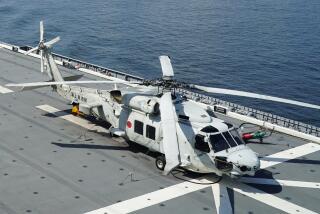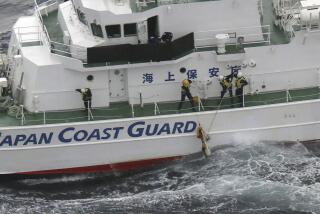NTSB Official Says Sub May Not Have Used Active Sonar
- Share via
HONOLULU — Government investigators said Sunday that Navy crewmen may not have taken the fullest safety precautions available to them before surfacing their nuclear submarine, which split open a Japanese fishing boat, leaving nine people still missing at sea.
Before practicing the emergency surfacing drill Friday off Oahu, the Greeneville’s crew checked the ocean’s surface twice with a periscope and once using so-called passive sonar, said John Hammerschmidt, a member of the investigating team of the National Transportation Safety Board.
Passive sonar simply listens for sounds, Hammerschmidt said. When a submarine engages active sonar, it send signals to the surface above to check for other vessels.
After a similar incident in 1989 when another nuclear submarine tangled with a tugboat off Long Beach, the NTSB recommended that Navy submarines use active sonar in all high-traffic coastal zones before ascending to periscope depth.
The Navy did not implement that safety recommendation, or two others, in the Greeneville’s ascent, Hammerschmidt said.
But he cautioned that it’s too early in the investigation to make parallels in the two incidents.
A Navy spokesman declined to comment Sunday night, saying the Navy had yet to hear the NTSB official’s statement.
As somber family members arrived here Sunday, armed with questions about how their loved ones’ fishing boat could have been sunk by the submarine, U.S. officials promised a full investigation and pledged reparations for their losses.
The search continued, yet hopes dimmed for the nine Japanese crew members, students and teachers lost at sea when the Greeneville rocketed to the surface and sliced open the Ehime Maru in 1,800-foot waters.
Coast Guard and Navy officials briefed more than a score of parents and siblings on the collision. At the meeting--planned for an hour but stretching to two--the families asked for explanations that no one has yet.
“The most important thing all the families want to know is why did it happen,” said Soichiro Takahama, deputy superintendent of the Ehime Prefecture’s Board of Education. The Japanese boat was carrying students from a high school, some training to become commercial fishermen.
Officials from the NTSB, which has jurisdiction over the accident, said the on-site investigation will take about a week to 10 days; the entire investigation could take about a year.
Investigators have already begun interviewing students who survived the collision so they could return home. Interviews with the submarine crew will begin Tuesday. Under standard operating procedures, drug tests have been conducted on the submarine’s key operating crew members, Hammerschmidt said.
Some family members of those missing asked to be taken to the collision site. “They said they had come this far and wanted to help with their own eyes and hands,” Takahama said.
That request “is being considered,” said Capt. Steven Newell, head of operations for the 14th Coast Guard District.
Newell said the Coast Guard planned to continue searching through the night Sunday and at least during daylight hours today.
“We intend to search as long as we feel there’s a reasonable chance of finding survivors from this tragic incident,” Newel said Sunday. “Certainly, the longer we go without signs that there are still people in the water, the more difficult it is to continue.”
The Ehime Maru, which was operated by Uwajima Marine and Fisheries High School in southwestern Japan, was observing tuna stocks nine to 12 miles south of Diamond Head when the Greeneville struck the much smaller vessel as the submarine rocketed out of the ocean’s depths during an emergency surfacing exercise. The boat sank within 10 minutes, and 26 aboard made it into lifeboats.
Ships, airplanes and helicopters from the Coast Guard and Navy pressed on with their search Sunday, which covered 4,675 square miles as of Sunday morning.
“We’ve had cases where people have survived days and days at sea,” said Coast Guard Petty Officer Lauren Smith, adding that water temperature is not the only determining factor. At a relatively warm 77 degrees, the Hawaiian waters will work in favor of those missing, but drift can be a problem.
“Drift also comes into play because, as you know, treading water can be tiresome,” she said.
In Washington, Defense Secretary Donald H. Rumsfeld said the Navy is investigating the cause of the collision and whether the submarine’s crew followed required procedures for surfacing.
“That’s what the investigation will determine,” Rumsfeld said Sunday on ABC-TV’s “This Week.” “There’s certainly no way to know in real time what took place.”
During an emergency surfacing exercise, submarines first check the ocean’s surface with sonar and a periscope. But instead of immediately surfacing, they dive 600 to 800 feet, use high-pressure air to expel seawater from their main ballast tanks and rocket upward, surfacing at about a 30-degree angle.
Capt. Hisao Onishi said that his fishing boat’s engines were running at the time of the accident and that it was traveling at 11 knots, or 12.6 mph. That should have alerted the submarine’s sonar to the boat’s location.
Sonar, however, isn’t perfect, and it can have trouble detecting ships that are directly behind a submarine or directly approaching it. A submarine captain, before surfacing, needs to reposition his vessel so that the sonar can sweep those “deaf” spots.
When the Greeneville struck the Ehime Maru during the surfacing operation, its usual crew was augmented by 15 civilians and a high-level Pacific Fleet sub officer.
Rumsfeld also said Sunday that the U.S. government was prepared to make reparations for the accident, pledging to “do the proper thing when the facts are fully sorted out.”
In Japan, Prime Minister Yoshiro Mori told reporters that the search for the missing is of the utmost importance, but he said it might be necessary to drag the sunken ship to the surface.
“I would like to convey the expression of protest,” Mori said during an apologetic visit Sunday night from U.S. Ambassador Thomas S. Foley. “I would like the U.S. government to give priority to the lives of the people and take every measure to pull up the training vessel.”
The Coast Guard on Sunday began talking with the Navy about the possibility of salvaging the Ehime Maru, which lies in waters estimated at 1,866 feet deep.
The Japanese family members heard from Capt. Onishi about the ordeal suffered by their loved ones. Neither family members nor Onishi spoke with media Sunday. But at an emotional news conference Saturday night, Onishi broke down in sobs as he recounted how he was unable to save everyone aboard.
“All I can say is, please forgive me,” Onishi said, his head bowed in the glare of TV lights and the cacophony of popping flashbulbs and camera shutters at the packed news conference. “I am so sorry.
“I ask only one thing--that the rescuers do their best to locate the nine missing people.”
*
Times staff writer Valerie Reitman in Tokyo contributed to this report.
More to Read
Sign up for Essential California
The most important California stories and recommendations in your inbox every morning.
You may occasionally receive promotional content from the Los Angeles Times.














